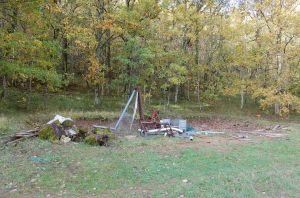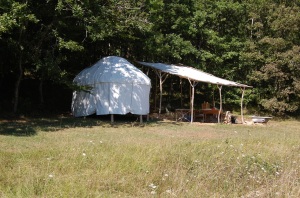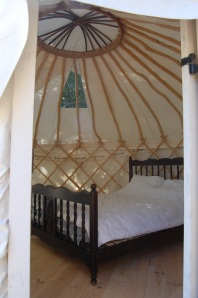September 2013
Monthly Archive
September 30, 2013
Posted by Alexander under
Uncategorized | Tags:
wood cutting |
[4] Comments

You may remember the log cutting bench on the left from this post last September (the wood shed in that post is currently empty and the experiment itself failed – the multiple log cutter collapsed on second use and I went back to the original bench).
I made the Mark I bench in a hurry in 2009 from some scrap wood and, like many quick fixes, it saw years more service than I would have thought.
But today I got around to making the Mark II, with a few design improvements that will be of interested to some of you:
- The new bench is 80 cm wide, which allows for 40 cm cuts to fit the fire.
- The middle support is centred, allowing for work from both sides.
- The point at which the round wood crosses has been raised a few cm, which suits my height better and will ease strain on my back.
- The upper horizontal braces have been dropped, so the saw won’t nibble them like it did on the old bench.
That’s the theory anyway. I haven’t actually used it yet and will let you know how it works out. Incidentally, the experiment from the other post was very labour saving and is still a good idea. But a portable, almost-free (it cost some nails and screws I already had) bench is still incredibly useful. You can put it together in a couple of hours and it will serve you well for years (or far longer).
September 29, 2013
The glamping season’s over for this year and the first leaves are falling.
Now tomatoes in the poly tunnel need roasting with garlic and blending for Winter sauces. Courgettes need turning into gratin and garlicky sauces. We’re waiting for the mushrooms to come through (while walking past lots of possibly edible mushies on the land, which is frustrating). And the temperature has dropped enough for me to do some of this:

It’s an oak the previous owner felled at least seven years ago (and tried to burn in situ!). I had hoped it might be dry enough for this year, but some of it was still wet in the middle. One morning with a chainsaw and splitter and it’s ready to keep us warm for a few days next year, or the year after. I’ve already stashed a few weeks of firewood under tarps or I’d really be panicking. One day I’ll be well ahead of the game, but this is not that day.
Her Outdoors, meanwhile, is working on her Christmas collection:

This is her third year of making decorations and it’s become part of our seasonal pattern. Fabric tree decorations will still be available and she’s working on some paper ideas. I’ll make details of her new Etsy shop known as soon as it’s open.
Pepito, meanwhile, is mowing the grass now the guests have gone. I’m currently wrestling with a new-used iPhone and shot a one-minute video you can see on the écovallée facebook page. The above photos were also shot with the iPhone. I’m yet to be convinced by the technology, as it doesn’t work – at all – as a phone. I can’t help feeling the product is badly named.
September 21, 2013
Posted by Alexander under
Uncategorized | Tags:
Foundis,
support |
[2] Comments
Since stepping off the hamster wheel of 21st Century mundanity, we’ve met some amazing people who are doing some incredible things.
People like Cathy and Greg, who designed and built a beautiful straw bale home near here. Eva and Manu, who wrote music while touring Europe in a camper van (as documented on their travel in music blog) and then got signed by Warner Music. Sarah and Philippe, who renovated and opened what is now our favourite restaurant (Les Petits Plats) in Couze. And dozens of guests and helpers who are doing fantastic things, or ordinary things fantastically well.
But this post is not about them.
This post is about a small, feisty Australian woman I met in London at the turn of the millennium. Phyllis Foundis.
At the time, Phyllis had written a book called The Virgin Club and was performing a one-woman show and faking orgasms in various venues in London. I know, what’s so special about that? After taking her show to the Edinburgh Fringe, she returned to Australia, had kids, wrote screenplays, and some words for money, and no doubt some other stuff. Aside from the odd email, we haven’t really been in touch.
Until this week.
This week, I’ve discovered this small woman has one of the biggest dreams I’ve ever heard. She’s creating a TV show. Just sit with that for a moment. We all have ideas about books, films, songs, pictures or whatever. Occasionally we start one but it rarely gets beyond an outline or a couple of pages of prose. Phyllis has come up with an idea, pour vast amounts of energy into it, assembled a team of famous (in Australia) people, made a pilot episode, and the first series of “Foundis” is set to air in January next year.
Why am I bothering to tell you this? Because Phyllis is crowd-sourcing the finance for her show and you are the closest thing I have to a crowd. You can find out more about the show here, and pledge some money here. If you only send her $25 AUS (which is not as much as it sounds, as their exchange rate isn’t great) you’ll get your name on the credits for the whole of the first series.
Imagine. Your name on TV for the equivalent of €17. For helping to make someone else’s dream a reality. If you’ve got lots of money and want to be credited as a Producer, you can do that too. Or you can just tell someone else and they can get the credit.
September 16, 2013
Posted by Alexander under
Uncategorized | Tags:
ecovallee |
1 Comment
Here’s the thinking behind our attempt to make as little money as possible from the écovallée yurt camp. If you’re a yurt camp (or glampsite) owner, you might find it interesting. If you’re looking for a glamping (or yurt camping) holiday, especially in France, you might find it illuminating.
And if you’re wealthy, this is why I probably never will be.
When écovallée opened in 2010, there was only one price for every week of the year. We had the notion that people shouldn’t be punished because they could only take their holidays during the Summer months. And besides (a word I can’t remember using before), our yurt camp was designed for people with young families (like us) who weren’t restricted to school holidays. So one price made sense. Yes?
Because facilities were minimal (we didn’t even have a yurt up when we started taking bookings), our opening price was low. So low, we didn’t actually make any money that year. (We even had to borrow money to pay the tax. Even I can’t argue this was good business.)
The following year, we had better facilities, increased our tariff a very small amount and kept to the single-price strategy. (You know, to be fair to everyone.) But any money we did make was ploughed back into the campsite. So we still didn’t “earn” anything.
By 2012, with the solar shower and tree bog finished, we realised what we had was a proper glampsite. We increased our price to well under half what some of our competitors were asking and held onto our single-price strategy. But we were alarmed (and dismayed, truth be told) to see that we only had guests during July and August.
Now, don’t get me wrong. July and August are good months. Of the six months we are open, they are certainly two of them. But other months here are wonderful. April mornings can be a bit nippy, but the wild orchids come out, exotic birds arrive, trees burst into the most vivid green, the tourist attractions open and are blissfully crowd-free… I’ll wax lyrical about that another time.
The point is, any “money” we “made” went back into the infrastructure and we ended up with “nothing”. “Again”. Which was getting pretty old.
Over the Winter, we were chatting to some of our more successful friends about our self-imposed plight. The single-price, fair-to-everyone-except-us idea was on the table. We still strongly felt that no one should have to pay more during the Summer holidays – that companies hiking their prices for July and August were robbing tourists blind. One of our friends then put it this way: What about if people just paid less when it’s not the Summer holidays?
I’m not ashamed of liking this idea. A lot. So much so, that we applied it immediately.
For 2013, we increased our prices to what is actually reasonable. Then slashed them for May, June and September. And cut them further still for April and October. And (at the risk of sounding like a Mr Men book) do you know what? It worked! For the first time, we had guests in every month except October. And for the first time, we “earnt” some “money” for ourselves. Yes, we’re still going to spend it on infrastructure, but it’s for us instead of the camp site. The camp site (except the car park and access road) is complete.
So we think we’ve got it right. Which means, we don’t think we need to change anything for 2014. Yes, I know this means we’re effectively charging 5%(ish) less than we were this year, but I can’t get all hot and bothered about the wrongness of a growth-based economy if I’m doing exactly the same thing, can I?
We’re happy with the prices at écovallée – and we hope our guests will be too. Next year, you’ll be able to stay in a yurt here for less than we were charging in 2010. What’s not to like about that?
September 11, 2013
When we’ve had bookings in the past, I’ve had to do the following things (not necessarily in this order):
o write the details into my computer’s calendar
o write the details into a spreadsheet
o open an Illustrator file and change the boxes on the calendar manually, copy and paste it into a Photoshop document, save it as a png, open an ftp program(me), copy the new file into the right folder, and refresh the page
o check it all works
This obviously left me wide open to a major panic when our computer got fried by lightning. It was a while before I realised much of the data was stored in the iCloud and could still be read, but my system was obviously far too complicated. I persevered for the rest of the 2013 season but, now it’s time to start thinking about next year, something had to change.
I spent literally a few minutes online and found a link in a forum that mentioned date blocker. I’ve spent literally some more minutes doing a test calendar that I offer you (and me – it’s mainly for me to be honest) as a trial. I’ve been given some code (one for embedding and one for a link) and I’m pasting them below. Let’s see what happens now.
Mustardseed
UPDATE
OK, the embedded code didn’t appear. I’ve now added the other two yurts, so here’s the new code for embedded and link. Remember, ladies and gentlemen, this is a test. There is no need to be alarmed.
Link code:
View availability
Embed (iframe – whatever that is) code:
ANOTHER UPDATE
That embed code just doesn’t want to play. But the link works. The calendar is clear, functional, but not pretty. I’ll sit with this for a while.
AND ANOTHER UPDATE
I ended up re-designing the whole website in WordPress. The calendar plug-in I use there cost about $29 and can be customised up to a point.
September 5, 2013
Back in November, in this post, I promised “an achingly beautiful 12-foot yurt with wooden floor, double bed and optional Moses basket, plus a baby-safe canvas-covered outdoor kitchen, featuring an off-grid fridge and grey water treatment”.
Here was the patch of land I started with:

And here it is today:

A little bit of (our) history
This yurt was originally going to be our family bathroom, way back at the start of the Big Green Idea. It’s the only yurt frame I actually helped to make, on a yurt building course with Matt and Mark in Stanmer Park (mentioned in more detail here). The frame is made from coppiced ash, much of which grew while we were living in Kemp Town a few miles away. It’s “achingly beautiful” as you can see…

…which fulfils part of that promise to you.
The canvas cover for the kitchen has also been with us from the beginning of this project. It was our groundsheet when we moved to France to live in a yurt just over six years ago. Although it didn’t appear in écovallée until June 2008 (I’ve never shown this shot before):

Since then, it has covered Pepito’s hay for several Winters, and has been dragged from one end of the field to the other (and back), for various reasons, numerous times. Her Outdoors squared it up and added an edge, using the last of our canvas, so we could put up the kitchen for only the cost of the string that goes round it.

As with other structures around here, the uprights for the kitchen and yurt platform are acacia from écovallée, sourced within a draggable distance.

The uprights for the kitchen side are oak from a few metres away. The sink was given to us a few years ago. The table came from a former hotel in Mauzac, as did the yurt door (which was a shutter originally) and bed frame. We did buy a new kitchen side and gas hob, and plumbing bits and pieces, but we’ve made every effort to keep the impact of this structure to a minimum.
Promise-wise, here’s the room for “an optional Moses basket”:

I was originally going to have the door facing down towards Pepito’s field, but I thought new parents might want to keep several eyes on the baby while they’ve having dinner, relaxing on the hammock, enjoying a bit of peace and quiet – and quite a lot of space.

One more shot before I go (it’s gone beer o’clock and it’s been fearsomely hot again today). There’s always something to be especially pleased with, even on quite a big project like this one. Here’s the bit of shaped shelving that makes me happy (cut with a seriously old coping saw that’s as blunt as a spoon):

There are a few more photos on an album on our facebook page. And I’ll take some proper shots for the website gallery when I’ve got a moment or few. But the only way to appreciate this little beauty properly is to come and see it for yourself.


















